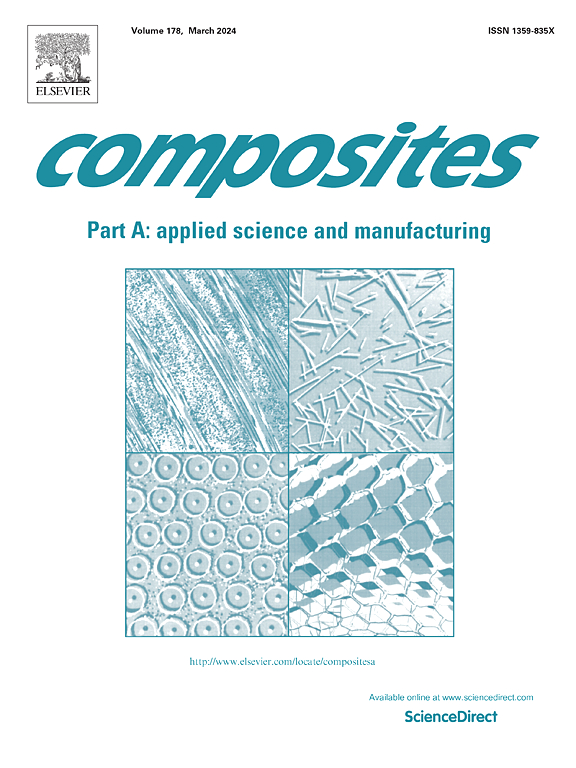基于结构驱动的单元胞模型的微观结构和粘弹性参数对生物纤维复合材料时间依赖性行为的影响分析
IF 8.1
2区 材料科学
Q1 ENGINEERING, MANUFACTURING
Composites Part A: Applied Science and Manufacturing
Pub Date : 2025-08-05
DOI:10.1016/j.compositesa.2025.109188
引用次数: 0
摘要
生物纤维复合材料表现出典型的各向异性粘-超弹性响应,粘弹性诱导耗散机制使其具有优异的抗冲击和疲劳性能。因此,将各向异性粘-超弹性模型应用到有限元分析中,研究其随时间变化的特性。通过采用结构驱动的单元胞模型(UCM),我们模拟应力松弛、蠕变和加载-卸载响应,以系统地量化纤维卷曲形态(卷曲幅度H、粗糙度ω、波浪度χ)和粘弹性参数(松弛时间τ、相对刚度γ)对随时间变化的力学行为的影响。数值结果表明,纤维的微观结构对生物纤维复合材料的整体刚度和抗蠕变性能起着至关重要的调节作用。粘弹性参数分析表明,松弛时间对粘弹性耗散速率起重要作用,相对刚度主要决定粘弹性耗散程度。值得注意的是,由于卷曲纤维的刚度比软基体高,因此对粘弹性行为表现出更高的敏感性,并且可以减轻其引起的应力集中。这项研究弥合了形态特征、粘弹性参数化和随时间变化的能量耗散之间的关键差距。松弛时间和相对刚度的量化灵敏度为设计具有可编程粘弹性的仿生复合材料提供了基础理论指导和经验数据支持,特别是在需要吸收冲击能量或抗疲劳的应用中。本文章由计算机程序翻译,如有差异,请以英文原文为准。

Microstructural and viscoelastic parameters effect analysis on the time-dependent behaviour of bio-fibrous composites based on a structure-driven unit cell model
Bio-fibrous composites exhibit typical anisotropic visco-hyperelastic responses, and the viscoelasticity-induced dissipation mechanism endows them with excellent impact resistance and fatigue properties. Accordingly, an anisotropic visco-hyperelastic model is applied and implemented into finite element analysis to investigate their time-dependent behaviour. By employing a structure-driven unit cell model (UCM), we simulate stress relaxation, creep, and loading–unloading responses to systematically quantify the effects of fiber crimp morphology (crimped amplitude H, roughness ω, waviness χ) and viscoelastic parameters (relaxation time τ, relative stiffness γ) on time-dependent mechanical behaviour. The numerical results indicate that the microstructure of fibers is critical in regulating the overall stiffness and creep resistance of bio-fibrous composites. The analysis of viscoelastic parameters reveals that the relaxation time plays a significant role in determining the rate of viscoelastic dissipation, and the relative stiffness mainly determines its degree. Significantly, the crimped fiber shows higher sensitivity to viscoelastic behaviour owing to its higher stiffness than the soft matrix, and the stress concentration caused by it can be alleviated. This study bridges critical gaps between morphological features, viscoelastic parameterization and time-dependent energy dissipation. The quantified sensitivity of the relaxation time and the relative stiffness provides foundational theoretical guidance and empirical data support for designing biomimetic composites with programmable viscoelasticity, particularly in applications requiring impact energy absorption or fatigue resistance.
求助全文
通过发布文献求助,成功后即可免费获取论文全文。
去求助
来源期刊

Composites Part A: Applied Science and Manufacturing
工程技术-材料科学:复合
CiteScore
15.20
自引率
5.70%
发文量
492
审稿时长
30 days
期刊介绍:
Composites Part A: Applied Science and Manufacturing is a comprehensive journal that publishes original research papers, review articles, case studies, short communications, and letters covering various aspects of composite materials science and technology. This includes fibrous and particulate reinforcements in polymeric, metallic, and ceramic matrices, as well as 'natural' composites like wood and biological materials. The journal addresses topics such as properties, design, and manufacture of reinforcing fibers and particles, novel architectures and concepts, multifunctional composites, advancements in fabrication and processing, manufacturing science, process modeling, experimental mechanics, microstructural characterization, interfaces, prediction and measurement of mechanical, physical, and chemical behavior, and performance in service. Additionally, articles on economic and commercial aspects, design, and case studies are welcomed. All submissions undergo rigorous peer review to ensure they contribute significantly and innovatively, maintaining high standards for content and presentation. The editorial team aims to expedite the review process for prompt publication.
 求助内容:
求助内容: 应助结果提醒方式:
应助结果提醒方式:


